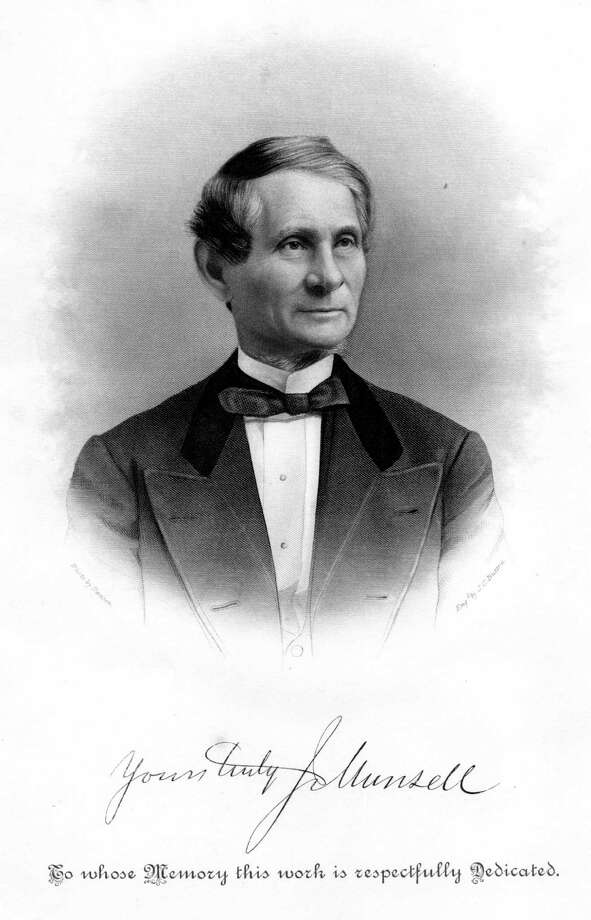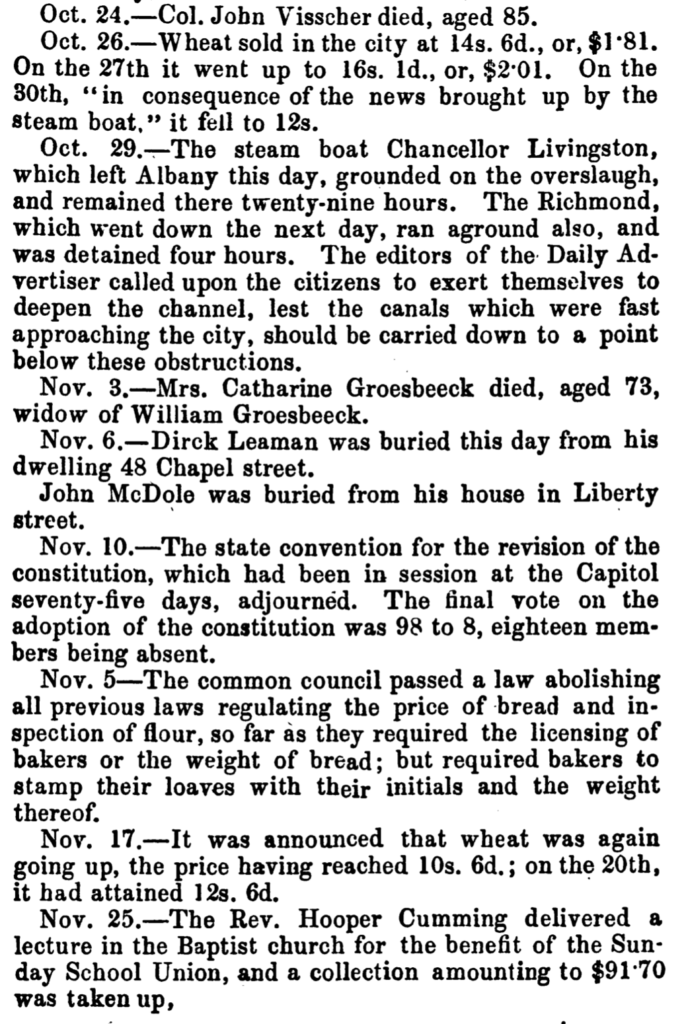Of all the Albany Bicentennial Tablets that have disappeared, perhaps the most ironic and unjust is the tablet celebrating printer and publisher Joel Munsell – no one has done more to record and preserve the history of the city of Albany, and in thanks, we commemorate him with: exactly nothing. Without his work, particularly “The Annals of Albany,” vast amounts of minutiae would have been lost. In 1886, when the Bicentennial tablets were being planned, his contributions and importance were well known, and this marker, unlike any other, expressed gratitude to the person being honored.
Bronze tablet, 16×22 inches, set in old gable building. Nos. 58 and 60 State street. Inscription:
“In gratitude to Joel Munsell, printer, of Albany, who, a native of Massachusetts, did more than all other men to preserve the Ancient Records of his adopted city. Born 1808—Died 1880. This is the spot where he begun [sic] his earliest work.”
In 1914, this one was already gone. The Argus wrote: “This site is now occupied by the National Commercial Bank. E.B. Noble, of the city engineer’s office, recalls that for some time this tablet stood in his office, and thinks that it may have been placed in the storeroom and covered with other material.”
That headquarters of the National Commercial Bank, later Key Bank, was built in 1903. There is no person more important to preserving the history of Albany than Joel Munsell was; it’s painful that no one made the effort to continue to commemorate him.

We’re going to rely heavily on a “Biographical Sketch of Joel Munsell” written and published by George Rogers Howell in 1880, with the full knowledge that on numerous occasions Howell has plagiarized badly, and incorrectly, so we have to take some of this with a grain of salt, but it’s also the most complete description of the life of Munsell we have.
Munsell’s father, a wagon builder, was born in Hartford, CT, and moved to Northfield, MA, shortly after his marriage to Cynthia Paine in 1807. Joel Munsell was born in Northfield on April 13, 1808. At 14, Munsell begin work in his father’s shop to learn the wheelwright’s trade, and pursued that for three years before deciding that he would prefer the life of a printer. At 17, in 1825, he started an apprenticeship in the Greenfield, MA, publishing offices for the Franklin Post and Christian Freeman.
He quickly became accomplished in setting up cases – accomplishment in those days was measured in how many “ems” of type could be set up in a day. Munsell set a local record, and within a year was the printing foreman of The Post. On Dec. 7, 1826, he switched to the Greenfield Gazette. In April 1827, the Gazette‘s owner sold his interest and established a bookstore in Albany, and brought Munsell with him to serve as clerk and manager of the business. He came to Albany May 2, 1827, just 19 years of age.
In November 1827, Munsell left Denio’s bookstore to briefly work on Solomon Southwick’s National Observer, but after only a month he was to be found working for the Masonic Record. Howell says it was only a two-day-a-week job (at $2 a day), which gave him time to work up plans for his own newspaper:
“In one day, along the principal business street, North and South Market, now Broadway, he procured one hundred and fifty subscribers; purchased a small font of types, and prepared for business. This paper was called the Albany Minerva, and was published semi-monthly, on a half sheet folded as a royal octavo. The composition was done in a back room of Mr. Denio’s bookstore, the use of which was paid by his attendance on customers while the clerk was absent at dinner. The paper was worked off at night on a Ramage press, with balls, in the Record office, and the next morning the editor delivered it at the doors of his subscribers. His object in this enterprise was not so much remuneration, as employment of an active brain and industrious hands. The labor involved in writing, type-setting and press-work, all of which he did himself, was so great that only eight numbers were issued, the first of which appeared Jan. 1, 1828, when he had not reached his twentieth year.”
Munsell took up the study of Latin, and began collecting volumes of newspapers from all parts of the United States. He went back to work for Denio for a few months, and then seems to have jobbed around the various newspapers or printing houses in Albany, and in Hartford and New Haven, at the time.

Howell then plunders Munsell’s diaries for memories of his first view of a railroad in 1832 (he didn’t rush out to see it), as well as his memories of the cholera outbreak of that year, when Munsell wrote that citizens burned tar to “purify the atmosphere.” He was skeptical of its effectiveness.
In 1834, Munsell and Henry Stone were published the weekly journal The Microscope, and in 1836 he was able to buy a job printing office at 58 State Street, which “laid the foundation of a long and prosperous career.” He published his first book, a compilation of others’ work really meant to serve as a printing specimen, in 1839: “The Outlines of the History of Printing.” Numerous other books followed, and he continued publication of “Webster’s Calendar, or the Albany Almanac” from the Websters who were related to Noah Webster. In later years, he moved to 82 State Street.
If you’re a researcher of Albany history, Munsell’s greatest contributions were his “Annals of Albany,” which he began in 1850 and completed in 1859, followed by the “Collections on the History of Albany,” which he published in several volumes from 1865 through 1871. Munsell pored through old newspaper and magazine editions and transcribed everything of conceivable interest or importance into these books, preserving them for our current use. Here’s an example of the minutiae captured in the Annals, from 1819:

And another example from 1821:

Munsell was the go-to publisher for small histories, genealogies, and such, and published perhaps thousands of them. None of this made him rich. It’s barely mentioned in any of his biographical sketches the he married and had children. Many children. He first married Jane C. Bigelow, on June 17, 1834; she died exactly 20 years later. Together they had four children, spaced out across 1835 to 1852. After Jane’s death, Munsell, now 48, married Mary Ann Reid in 1856, and together they had six children. His oldest son with Mary Ann, Frank, took over the printing business when Munsell died.
According to Lillian Buttre’s “The American Portrait Gallery: With Biographical Sketches …,” Munsell died at his home at 59 Lodge Street on January 15, 1880, at 71 years of age. Cause of death, according to his burial card at Albany Rural Cemetery, was “paralysis.” At the time he was working on a chronology of journalism, and had collected more than 10,000 specimen newspapers from England and the United States, which he had bound and deposited in the State Library. Buttre chose to include Munsell in a volume that also sketched the lives of Henry W. Longfellow, Jefferson Davis, William Henry Harrison, and Chester A. Arthur, if that gives an impression of the. esteem in which Munsell was once held.

Leave a Reply